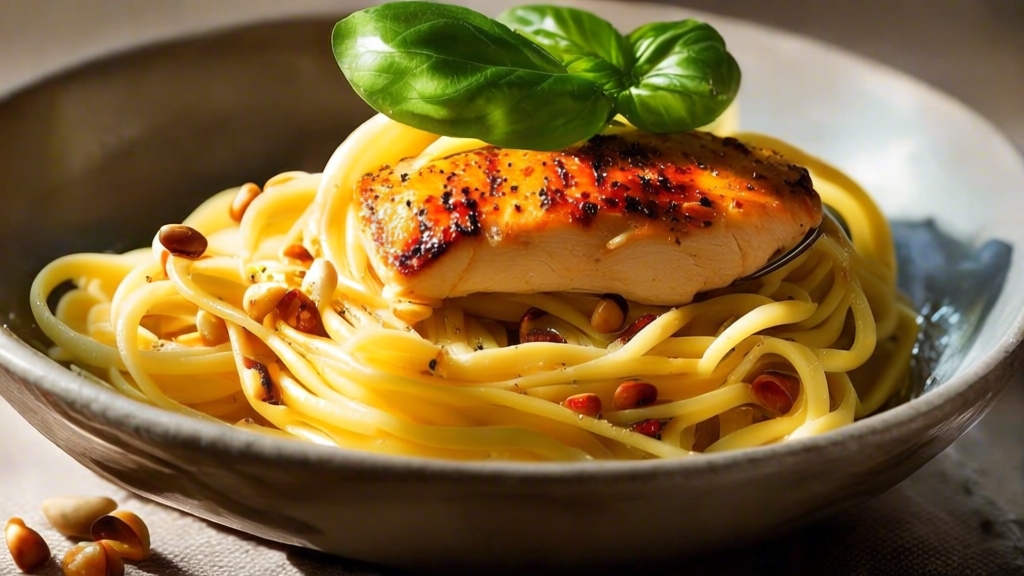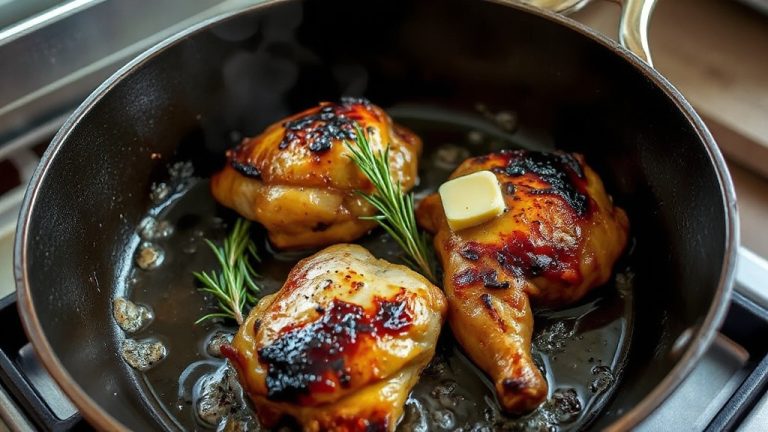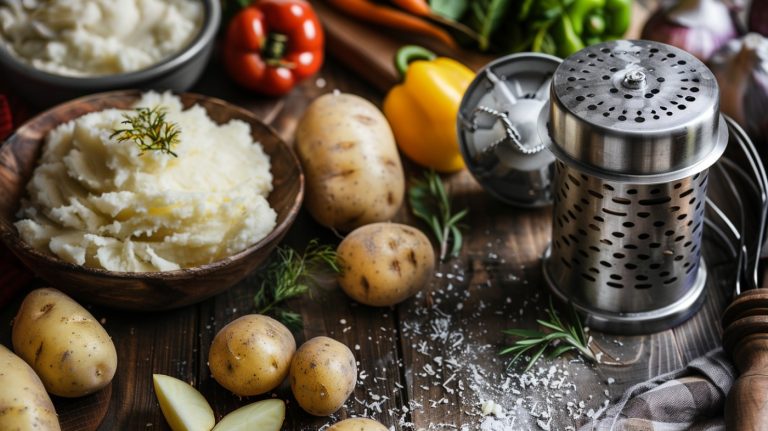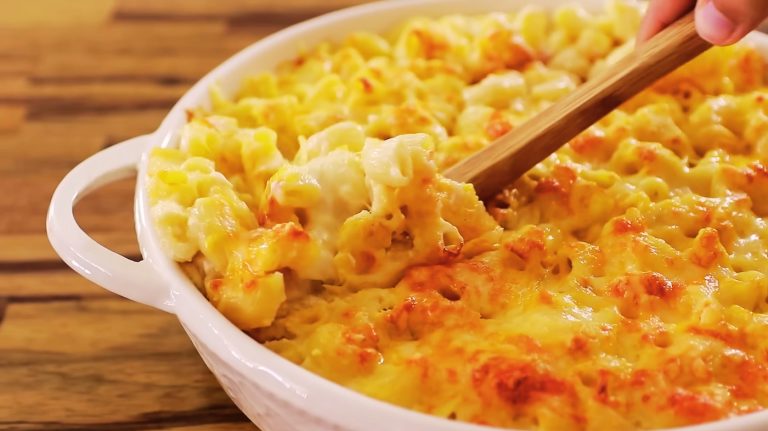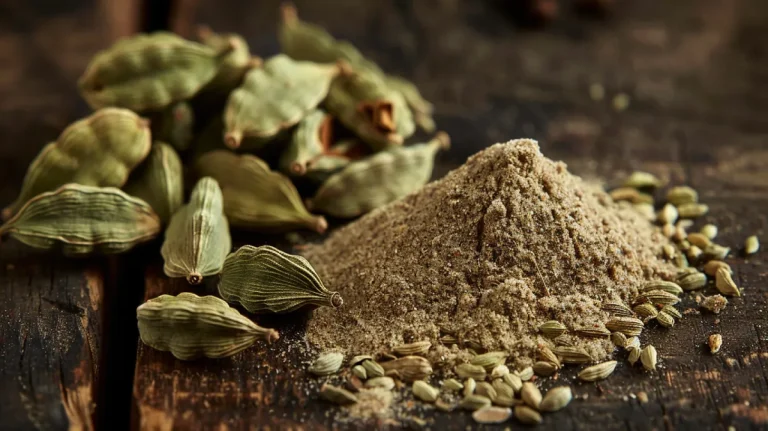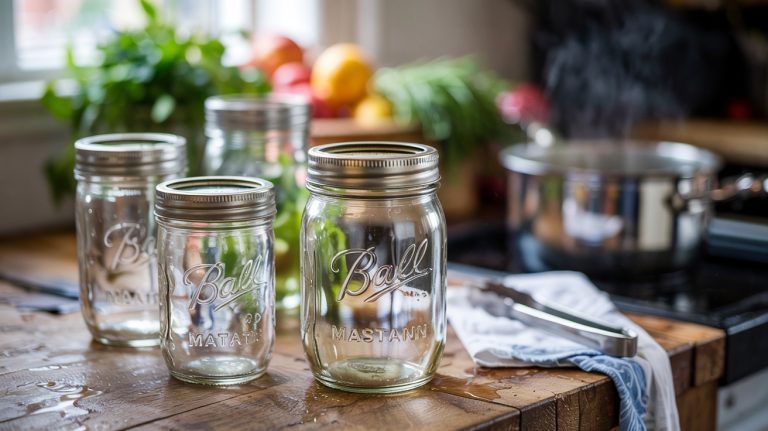Chicken Pasta Recipe Without Cream: Healthy Comfort Food
You can make a luscious chicken pasta without cream by using Parmesan cheese, butter, and starchy pasta water to create a rich, velvety sauce.
Start with well-seasoned, roasted chicken for deep flavor and cook your pasta just right, reserving some pasta water to help thicken the sauce naturally.
Combining these elements gently guarantees each bite is creamy yet light. Ready to open secrets for perfectly balanced seasonings and effortless techniques?
Key Takeaways
- Use whole milk thickened with flour or Parmesan cheese to create a creamy sauce without heavy cream.
- Season and roast chicken for juicy, flavorful pieces before slicing and adding to pasta.
- Cook pasta al dente and reserve starchy pasta water to naturally thicken and bind the sauce.
- Whisk butter and flour into a roux, then gradually add milk for a smooth, velvety sauce base.
- Combine pasta, chicken, and sauce gently, adjusting seasoning and adding pasta water for perfect texture.
How to Cook Chicken Pasta Without Cream? Quick Steps
| Ingredients / Tools | Steps / Actions |
|---|---|
| 2–3 chicken breasts or thighs | Season, brine, or marinate chicken; roast, poach, or sear until cooked through |
| 250g pasta (fusilli, rigatoni, or spaghetti) | Cook in salted boiling water until al dente; reserve ½ cup starchy water |
| 2 tbsp olive oil or butter | Heat in pan for sautéing chicken and aromatics |
| 2 cloves garlic or shallots | Sauté until fragrant for flavor base |
| 1 tbsp flour (optional) | Whisk with butter to make a roux if thicker sauce is desired |
| 1 cup whole milk | Gradually add to roux for cream-free velvety base |
| ½ cup Parmesan cheese | Stir into sauce until melted and silky |
| ¼ cup white wine or broth (optional) | Add for depth and light acidity |
| Fresh vegetables (spinach, sun-dried tomatoes, mushrooms, zucchini) | Sauté separately to reduce water before adding |
| Salt, pepper, lemon juice | Adjust seasoning to taste before serving |
| Reserved pasta water | Stir in gradually to bind sauce and adjust consistency |
| Knife & cutting board | Slice rested chicken evenly before combining |
Ingredients for a Cream-Free Chicken Pasta
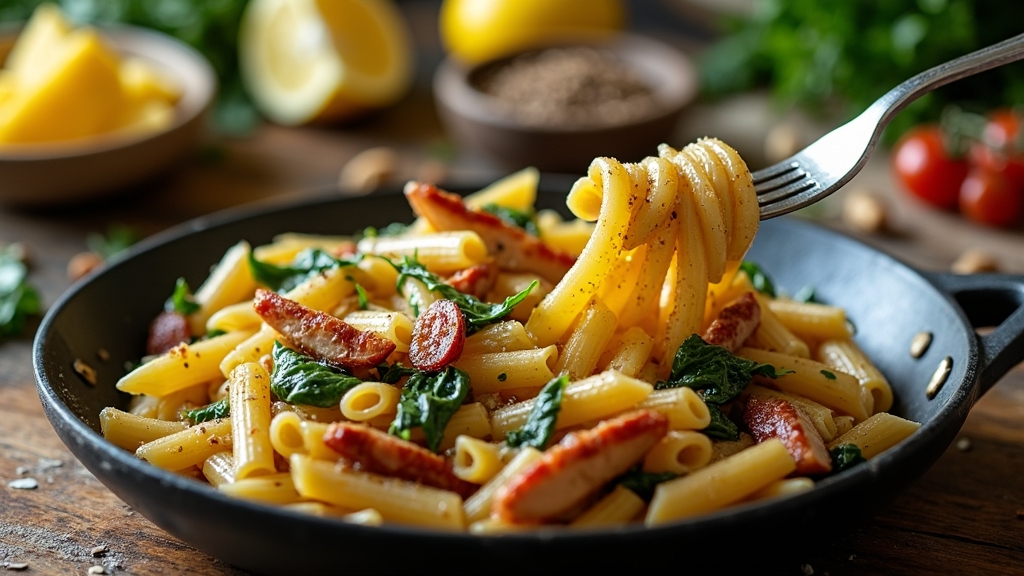
When you want a creamy chicken pasta without using heavy cream, you can rely on ingredients like whole milk, Parmesan cheese, and butter to achieve that rich texture.
Whole milk, thickened with a bit of flour, forms a smooth base, while Parmesan cheese not only boosts flavor but also naturally thickens the sauce.
Using whole milk thickened with flour and Parmesan creates a creamy, flavorful sauce naturally.
Butter, used sparingly, adds silkiness without overwhelming richness. To deepen flavors, you might incorporate white wine and aromatic garlic or shallots. Using a high-quality extra virgin olive oil to sear the chicken adds a flavorful foundation to the dish. Proper preparation, including cleaning and preparing the knife, ensures precision when chopping ingredients, which contributes to the overall texture and presentation.
Starchy pasta water helps bind the sauce, creating a velvety consistency that clings beautifully to the noodles.
Olive oil can replace or complement butter for a lighter richness. Fresh leafy greens and sun-dried tomatoes contribute freshness and tang, balancing the dish perfectly without any heavy cream needed.
Preparing the Chicken for Optimal Flavor
Although choosing the right chicken cut might seem straightforward, it plays a crucial role in achieving ideal flavor and texture for your pasta dish. Opt for bone-in, skin-on pieces to retain moisture and deepen flavor, or pick smaller breasts for tenderness.
Before cooking, dry brine your chicken with salt for 2 hours to 2 days, or wet brine with herbs for about 45 minutes to enhance juiciness. Marinate with olive oil, garlic, citrus zest, and spices to infuse complex tastes. For consistent, flavorful results, consider roasting the chicken at a high temperature to develop a crispy skin and rich flavor.
Pounding chicken to an even thickness ensures uniform cooking, preventing dry edges. Use gentle cooking methods like poaching or pan-searing to lock in juices.
Finally, let the chicken rest briefly so flavors settle and textures stay moist, making every bite perfect in your cream-free pasta.
Cooking Pasta and Reserving Starchy Water
After preparing your chicken with care, it’s time on focusing on cooking the pasta perfectly and making the most of the starchy water it releases.
Start by boiling plenty of water, seasoning it generously with about one tablespoon plus a teaspoon of salt per gallon. Using non-porous materials for your cookware can help maintain the integrity of your ingredients.
Boil plenty of water, seasoning generously with about one tablespoon plus a teaspoon of salt per gallon
Add the pasta only once the water is at a rolling boil. Skip the oil to ensure sauces cling well.
Cook the pasta until just al dente, so it finishes cooking later in the sauce without getting mushy.
Before draining, reserve about half a cup of the cloudy, salty pasta water. This starchy water is a secret weapon.
Its composition of starches thickens the sauce and helps it bind beautifully to the pasta.
It helps thicken your sauce, binding it smoothly to the pasta and enhancing flavor integration for a richer, silkier finish.
Crafting a Velvety Sauce Without Cream
Crafting a velvety sauce without cream challenges you to explore rich, flavorful alternatives that deliver luscious texture and depth.
Parmesan cheese combined with starchy pasta water naturally thickens, melting into a silky coating that’s far from muted. This method uses parmesan cheese and pasta water to create creaminess without any dairy cream. Using a gentle simmer helps maintain the sauce’s smooth consistency without curdling.
You can also create a roux by blending butter and flour, then gradually whisking in full-fat milk for a creamy, controlled finish, enhanced by garlic’s aroma and a final sprinkle of Parmesan.
Broth thickened with cornstarch, along with sautéed onions and a splash of dry white wine, offers a lighter, elegant option. This technique is similar to how chefs employ sweeping movements to ensure even texture in sauces.
Alternatively, cook down zucchini or mushrooms to release their natural starches and umami, blending with reserved pasta water and finishing with butter and cheese for a rich, balanced sauce—no cream needed.
Combining Pasta, Chicken, and Sauce for Serving
When you combine pasta, chicken, and sauce, timing and technique play crucial roles in creating a harmonious dish.
After cooking, let the chicken rest to retain juiciness, then slice or cube it evenly. This step helps the chicken stay tender and flavorful, which is especially important when using boneless, skinless chicken breast. To maintain the best texture, avoid drying out the chicken by warming it gently, a method often recommended in maintenance of protein stains.
Add the pasta to the simmering sauce, stirring occasionally to prevent sticking and encourage even coating. Incorporate reserved pasta water if needed to achieve a smooth, luscious texture.
Gently fold the chicken into the pasta and sauce near the end of cooking to warm it through without drying it out. Toss everything carefully to distribute flavors while preserving the chicken’s texture.
Finally, adjust seasoning with salt, pepper, or lemon juice. This approach ensures balanced flavors and a visually appealing, restaurant-quality plate every time.
Frequently Asked Questions
Can I Substitute Chicken Breast With Thighs for This Recipe?
Yes, you can substitute chicken breasts with thighs in your recipe. Thighs bring richer flavor and stay juicy even with longer cooking, so your pasta will taste more savory and moist.
Just adjust cooking times since thighs take a bit longer to cook through. Expect a firmer, chewier texture that adds depth.
This swap is great if you want a more indulgent, flavorful dish without adding cream.
What Is the Best Type of Pasta for a No-Cream Sauce?
If you want pasta that hugs every drop of your no-cream sauce like it’s its soulmate, go for fusilli, rigatoni, or cavatappi. Their twists and ridges trap olive oil and garlic like a flavor magnet.
Spaghetti and linguine also shine, letting silky oil-based sauces glide effortlessly.
For something playful, farfalle’s pinched centers catch light sauces perfectly. Choose pasta that holds sauce and texture boldly, turning simple ingredients into a taste explosion.
How Do I Store Leftovers to Keep the Sauce Creamy?
To keep your sauce creamy, store it separately from the pasta in airtight glass or BPA-free plastic containers. Label them with the date and refrigerate within two hours at 40°F or below.
Cool the sauce to room temperature before refrigerating to avoid condensation.
When reheating, use low heat and stir often, adding a splash of broth or pasta water to revive creaminess.
Avoid frequent temperature changes to maintain texture and flavor.
Can I Add Vegetables Without Making the Sauce Watery?
Yes, you can add vegetables without making the sauce watery. Just sauté them separately at medium-high heat to evaporate excess moisture before mixing them in.
Choose firmer, low-water veggies like bell peppers or carrots, and consider adding tomato paste or a cornstarch slurry to thicken the sauce.
Simmering uncovered helps reduce liquid, and pureeing some veggies into the sauce adds body. These steps keep your sauce rich and balanced.
Is This Recipe Suitable for Gluten-Free Pasta Options?
Yes, you can definitely use gluten-free pasta in this recipe. Just pick a type like rice, corn, or legume-based pasta that matches your preferred texture.
Since there’s no cream, the pasta’s natural flavor will shine, especially with legume varieties adding nuttiness. Keep an eye on cooking times to avoid mushiness, and your chicken pasta will turn out delicious and safe for gluten-sensitive diets without compromising taste or texture.
Simple Swaps, Delicious Results – Time to Cook
You might think skipping cream means sacrificing that rich, silky sauce, but this recipe proves otherwise. By using starchy pasta water and a blend of flavorful ingredients, you’ll create a luscious, velvety coating that clings perfectly to tender chicken and pasta.
It’s lighter, fresher, and just as satisfying. Give it a try—you’ll love how simple swaps can elevate your dish without any heaviness or guilt.

